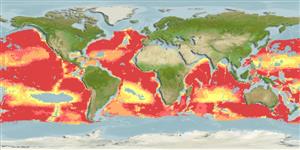Actinopterygii (ray-finned fishes) >
Ophidiiformes (Cusk eels) >
Ophidiidae (Cusk-eels) > Neobythitinae
Etymology: Abyssobrotula: Greek, abyssos, deep, depth + Latin, brotula = little bud, shoot (Ref. 45335). More on author: Nielsen.
Environment / Climate / Range
Ecology
Marine; bathypelagic; depth range 3110 - 8370 m (Ref. 3686). Deep-water, preferred ?; 46°N - 48°S, 166°E - 25°E
In deep waters of tropical and subtropical areas of all oceans. 3 specimens from the Gulf of Guinea (Ref. 3686).
Size / Weight / Age
Maturity: Lm ? range ? - ? cm
Max length : 16.5 cm SL male/unsexed; (Ref. 3686)
Short description
Morphology | Morphometrics
Head short with downward inflection. Snout swollen. Eyes small. Poorly developed opercular spine. Anterior gill arch with 8-11 developed gill rakers. Precaudal vertebrae 18-21.
Uncommon species (Ref. 34024). Reproductive strategy possibly similar to other members of this family being oviparous, with oval pelagic eggs floating in a gelatinous mass (Ref. 205).
Life cycle and mating behavior
Maturity | Reproduction | Spawning | Eggs | Fecundity | Larvae
Nielsen, J.G., 1990. Ophidiidae. p. 564-573. In J.C. Quero, J.C. Hureau, C. Karrer, A. Post and L. Saldanha (eds.) Check-list of the fishes of the eastern tropical Atlantic (CLOFETA). JNICT, Lisbon; SEI, Paris; and UNESCO, Paris. Vol. 2. (Ref. 3686)
IUCN Red List Status (Ref. 115185)
CITES (Ref. 94142)
Not Evaluated
Threat to humans
Harmless
Human uses
Fisheries: of no interest
More information
Age/SizeGrowthLength-weightLength-lengthLength-frequenciesMorphometricsMorphologyLarvaeLarval dynamicsRecruitmentAbundance
Tools
Special reports
Download XML
Internet sources
Estimates of some properties based on models
Phylogenetic diversity index (Ref.
82805): PD
50 = 1.0000 [Uniqueness, from 0.5 = low to 2.0 = high].
Bayesian length-weight: a=0.00407 (0.00156 - 0.01061), b=3.12 (2.90 - 3.34), in cm Total Length, based on LWR estimates for this (Sub)family-body shape (Ref.
93245).
Trophic Level (Ref.
69278): 3.5 ±0.6 se; Based on size and trophs of closest relatives
Resilience (Ref.
69278): Medium, minimum population doubling time 1.4 - 4.4 years (Assuming tmax>3).
Vulnerability (Ref.
59153): Low vulnerability (23 of 100) .
